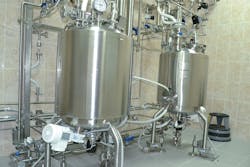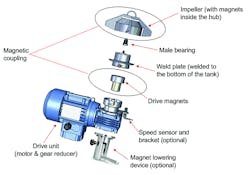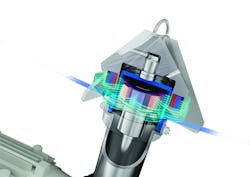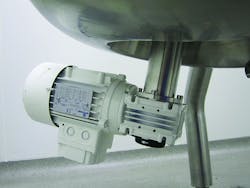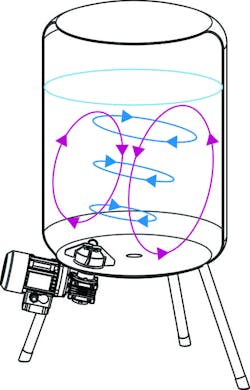Mag mixers for food and beverage processing
Recalls and cross-contamination issues continue to plague food and beverage producers. Quite often, the problem can be traced back to a process step that is done in an open vessel. The pharmaceutical industry has addressed this by using closed vessels with magnetically driven agitators known as mag mixers, but the continued growth of the use of mag mixers is not limited to applications in the pharmaceutical market. There are also significant advantages in the food and beverage markets.
Mag mixers have been a staple in pharmaceutical processes since their inception, but there has always been an imaginary dividing line between the sanitary requirements in the pharmaceutical industry and those of other sanitary industries. For example, "clean" in the food and beverage industry isn’t the same as "clean" in the pharmaceutical industry. That line is becoming blurrier every day. Today, terms like ultraclean, ultrasanitary and hygienic are commonly used, but their interpretation seems to vary from one person to the next. Regardless of one’s interpretation, it is easy to see that the food and beverage industry is heading in the direction of the pharmaceutical industry in terms of sanitary practices. As product recalls grow more prevalent, the need for the industry to have isolation and containment during processing has never been more prominent.
Figure 1. Anatomy of a mag mixer
The potential for contamination exists in any unit operation that exposes the product to the environment, or the environment to the product. Quite often, mix tanks are the biggest culprit in the process. Every time a manway is opened, there is a risk of contamination. Most food and beverage processes are run in open tanks and mixing is a critical step. An open tank presents one of the greatest risks for contamination in the entire plant. Closed tanks would address the problem, but mechanical seals on mixers are expensive to purchase, maintain and run. Seal components are subject to degradation due to the process, clean in place (CIP), sanitize in place (SIP), improper installation, pH, steam, chemical compatibility, cycling and shaft runout. Despite users’ best efforts to operate them as intended, mechanical seals do weep between their faces. A much less expensive option for a mixer on a closed tank is a lip seal. It is a big step down from a mechanical seal, but it still provides some protection when compared to an open tank. While less expensive than a mechanical seal, a lip seal is more of a rain hat than an actual seal — it does almost nothing to help isolate and contain the process. Ultimately, the decision is usually made by considering the costs and the level of risk that the plant can tolerate.
Figure 2. How a mag mixer is installed in a tank
Magnetically driven pumps are well known to most food and beverage producers, but magnetically driven mixers are still relatively new outside of the pharmaceutical industry. Mag mixers have been in operation for decades. At first, they were only an option on small volumes because the impeller diameters were small and the motors were in fractional horsepower (hp) sizes. Today, a 5 hp mag mixer for a 10,000-gallon tank is a standard product. The first industry to standardize on mag mixers for certain applications was the pharmaceutical industry. Why would the industry with the most stringent requirements for cleanliness use this technology? Simple. The mag mixer does not require a penetration in the tank, like a top-entry, side-entry or bottom-entry mixer does. No penetration means no rotating shaft and no need for a seal. No seal means no leak path — basically, what’s in, stays in and, what’s out, stays out.
To fully understand this, let’s look at the anatomy of a mag mixer (Figure 1). The weld plate is welded into the bottom dish (or cone) of the tank and becomes part of the tank, as shown in Figure 2. The impeller is installed on the replaceable male bearing that is located inside the tank. Strong magnets are located inside the wall of the impeller. The drive unit, consisting of a motor, gearbox, drive magnets and mounting flange, is installed on the outside of the tank. The magnets inside and outside the tank form a magnetic coupling as shown in Figure 3. When the motor turns, the impeller turns along with it. The magnetic coupling does the same job as a mechanical coupling on a mixer with a shaft, but without the physical connection.
Reasons to use mag mixers in food and beverage processing
Aseptic processing plants, which are closest to pharmaceutical plants in the way they address their process requirements, were among the first food and beverage plants to use mag mixers.
The six key reasons why mag mixers are used are:
Figure 3. Magnetic coupling
Mag mixers are typically a good choice for applications such as storage, liquid/liquid blending of miscible fluids, solids suspension, heat transfer, and dissolving of solids such as salts and sugars. These are generally grouped together as flow-driven applications and the proper flow pattern in the tank is shown in Figure 4. This is the same tank turnover pattern (top-to-bottom motion, plus some vortexing) that is produced by a top-mount mixer installed off-center.
Another factor to consider is the increasing value of the product as it moves downstream in the process. At the beginning of the process, the product is essentially a group of raw ingredients in storage tanks. At the end of a process, the product has gone through several steps — mixing, heat treatment and filtration, for example. All of these steps cost money and when the product is being filled into bottles, jars or containers, it has its highest value. So, why are so many filling lines fed with product coming from an open tank?
Steridose Sterimixer on tank
Reasons not to use a mag mixer
While the benefits discussed here may dramatically tip the scales in favor of mag mixers, the decision is highly dependent on the application. There are also several reasons not to use a mag mixer.
Viscosity. The effect of viscosity can be best understood if viscosity is considered to be nothing more than a resistance to flow. Mixing is essentially the same as pumping, but mixing is done inside a vessel, whereas pumping is done within a pipingsystem. A higher viscosity product has a greater resistance to flow — it is more difficult to pump, whether it is being pumped in-line or in-tank. A good rule of thumb is that a mag mixer can be used on products up to 1,000 centipoise (cP), although some mag mixer companies will cite a lower viscosity limit. It may also be possible to properly mix products that are above 1,000 cP, depending on if they are Newtonian or non-Newtonian. When considering mag mixers for viscous products, the best approach is to contact the mixer manufacturer for assistance.Figure 4. A mag mixer’s flow patterns
Conclusion
When an engineer designs a process, he or she must choose components using the "right-tool-for-the right-job" approach. There are always choices to be made. It’s the engineer’s job to make sure the process works as intended, the risks are minimized and the costs are within budget. The bottom-mount mag mixer is another tool for the engineer’s toolbox. It is a well-established process component with a proven track record of successfully addressing some of the biggest concerns in the pharmaceutical industry — the same concerns that are overwhelming the food industry.
Another factor in the growing use of mag mixers in the food and beverage industry is the movement of people from one industry to the other. People change jobs (or industries) and take their best ideas with them. This cross-pollination can bring a fresh, new approach.
Overall, mixing is a critical unit operation in food and beverage plants, yet it is one of the least understood operations in the plant. Quite often, the best way to consider alternative approaches is to try them. Some mag mixer manufacturers have portable tanks with mixers that can be rented for small-scale trials. Some also have labs where a trial can be performed. A less hands-on approach would be to model the process using computational fluid dynamics (CFD).
Frank Sequino is the North American sales manager at Steridose, a manufacturer of magnetically driven mixers. Sequino has spent the majority of his career working for manufacturers of sanitary process equipment, with a heavy concentration on mixers. During his career, he has been a process engineer, project manager, application engineer and sales manager. Sequino has a Bachelor of Science in Chemical Engineering from the University of Rochester.
